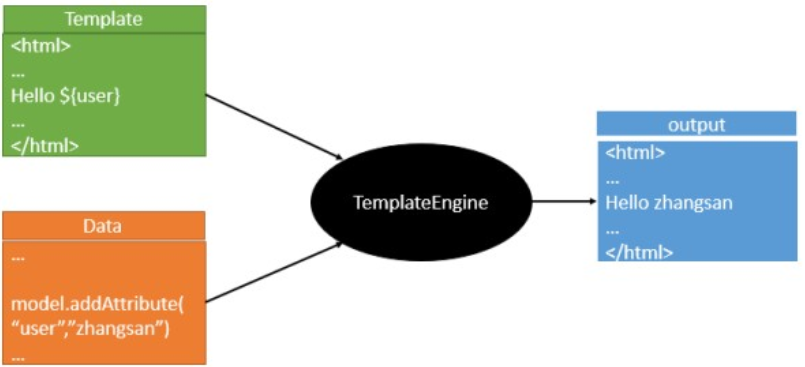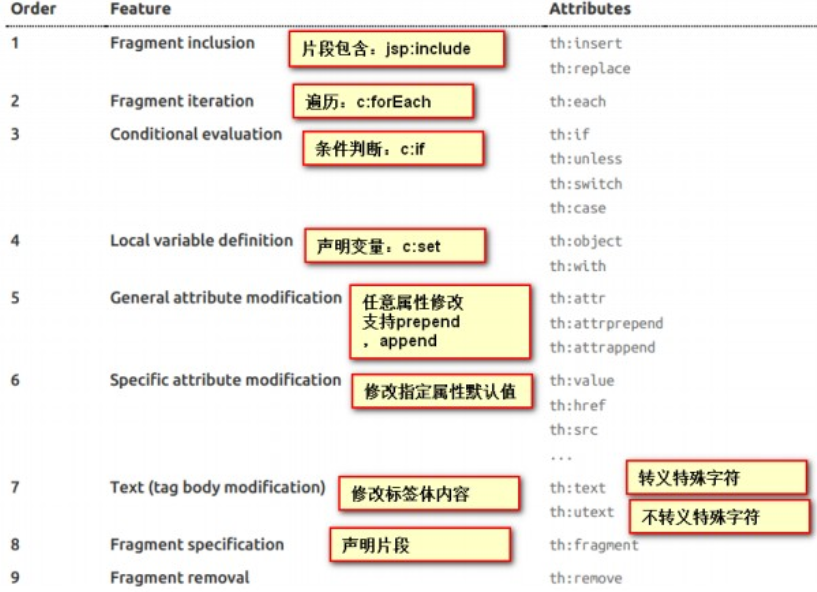# 一、模板引擎的思想
模板是为了将显示与数据分离,模板技术多种多样,但其本质都是将模板文件和数据通过模板引擎生成最终的HTML代码。

# 二、SpringBoot模板引擎
SpringBoot推荐的模板引擎是Thymeleaf语法简单,功能强大。
【1】引入thymeleaf的 starter启动器。
<dependency>
<groupId>org.springframework.boot</groupId>
<artifactId>spring-boot-starter-thymeleaf</artifactId>
</dependency>
<!-- 默认版本号在parent的dependents中配置,如果要替换其中的版本,设置如下 -->
<properties>
<thymeleaf.version>3.0.2.RELEASE</thymeleaf.version>
<!-- 布局功能的支持程序 thymeleaf3主程序,适配layout2以上版本 -->
<thymeleaf-layout-dialect.version>2.1.1</thymeleaf-layout-dialect.version>
</properties>
2
3
4
5
6
7
8
9
10
11
【2】查看thymeleaf的默认配置:进入ThymeleafAutoConfiguration的ThymeleafProperties配置文件中,如下:
@ConfigurationProperties(
prefix = "spring.thymeleaf"
)
public class ThymeleafProperties {
private static final Charset DEFAULT_ENCODING = Charset.forName("UTF-8");
private static final MimeType DEFAULT_CONTENT_TYPE = MimeType.valueOf("text/html");
public static final String DEFAULT_PREFIX = "classpath:/templates/";
public static final String DEFAULT_SUFFIX = ".html";
private boolean checkTemplate = true;
private boolean checkTemplateLocation = true;
//只要我们吧HTML页面放在classpath:/templates/下就能够自动渲染
private String prefix = "classpath:/templates/";
private String suffix = ".html";
}
2
3
4
5
6
7
8
9
10
11
12
13
14
【3】测试:创建controller如下:同时在templates文件夹下创建suceess.html与返回值相同。启动后输入:http://localhost:8080/success 便可跳转到success.html页面。
@Controller
public class success {
@RequestMapping("/success")
public String success(){
return "success";
}
}
2
3
4
5
6
7
# 三、thymeleaf 使用
【1】导入thymeleaf的名称空间:就会具有thymeleaf的语法提示,不导入也可以,只是么有语法提示了。
<html lang="en" xmlns:th="http://www.thymeleaf.org">
【2】写一个简单的demo上个手,如下controller层,给返回的页面添加数据,如下:
@Controller
public class success {
@RequestMapping("/success")
public String success(Map<String,String> map){
map.put("hello","你好");
return "success";
}
}
2
3
4
5
6
7
8
【3】打开我们的静态页面success.html,根据thymeleaf模板引擎语法,获取hello的值,如下:
<body>
<h1>成功</h1>
<div th:text="${hello}">
这是成功页面
</div>
</body>
2
3
4
5
6
【4】需要注意的是:当hello有值时,显示 hello获取到的值,如果单独只访问 success.html时,只显示前端页面的内容 “这是成功页面” 能够非常友好的结合前后端进行编程。
# 四、thymeleaf语法规则
【1】th:text:改变当前元素里面的文本内容。语法文档:https://www.thymeleaf.org/doc/tutorials/3.0/thymeleafspring.pdf
th:任意html属性:可以替换原生的HTML的元素。

【2】表达式语法:行里表达式:[[xx]] —>相当于 th:text , [(xx)]—>相当于th:utext
● Simple expressions:(表达式语法)
○ Variable Expressions: ${...}:获取变量值,底层时OGNL;
1)、获取对象的属性、调用方法;
2)、使用内置的基本对象;#location...
3)、内置的一些工具对象;#strings...
○ Selection Variable Expressions: *{...}:选择表达式,与${}的功能一样,有一个不同,可以参考文档。
○ Message Expressions: #{...}:用来获取国际化信息
○ Link URL Expressions: @{...}:用来定义URL连接
○ Fragment Expressions: ~{...}:片段引入表达式
● Literals(字面量)
○ Text literals: 'one text' , 'Another one!' ,…
○ Number literals: 0 , 34 , 3.0 , 12.3 ,…
○ Boolean literals: true , false
○ Null literal: null
○ Literal tokens: one , sometext , main ,…
● Text operations:(文本操作)
○ String concatenation: +
○ Literal substitutions: |The name is ${name}|
● Arithmetic operations:(数学运算)
○ Binary operators: + , - , * , / , %
○ Minus sign (unary operator): -
● Boolean operations:(布尔运算)
○ Binary operators: and , or
○ Boolean negation (unary operator): ! , not
● Comparisons and equality:(比较运算)
○ Comparators: > , < , >= , <= ( gt , lt , ge , le )
○ Equality operators: == , != ( eq , ne )
● Conditional operators:(条件运算)
○ If-then: (if) ? (then)
○ If-then-else: (if) ? (then) : (else)
○ Default: (value) ?: (defaultvalue)
○ Special tokens:
○ Page 17 of 106
● No-Operation: _:(特殊操作)
2
3
4
5
6
7
8
9
10
11
12
13
14
15
16
17
18
19
20
21
22
23
24
25
26
27
28
29
30
31
32
33
34
【3】公共页面抽取
<!--抽取公共片段-->
<div th:fragment="copy">
2011 The Good Thymes Virtual Grocery
</div>
<!--引入公共片段: ~{templatename::fragmentname} 片段 ~{templatename::selector} 选择器-->
<div th:insert="~{footer :: copy}"></div>
<-- or -->
<div th:insert="footer :: copy"></div>
2
3
4
5
6
7
8
9
三种引入功能片段的区别:
▶ th:insert:将公共片段整个插入到声明引入的元素中。
▶ th:replace:将声明引入的元素替换成公共片段。
▶ th:include:将被引入的片段的内容包含进这个标签中。
<footer th:fragment="copy">
2011 The Good Thymes Virtual Gro
</footer>
<!--引入方式-->
<div th:insert="footer :: copy"></di>
<div th:replace="footer :: copy"></div>
<div th:include="footer :: copy"></div>
<!--效果-->
<div>
<footer>
2011 The Good Thymes Virtual Grocery
</footer>
</div>
<footer>
2011 The Good Thymes Virtual Grocery
</footer>
<div>
2011 The Good Thymes Virtual Grocery
</div>
2
3
4
5
6
7
8
9
10
11
12
13
14
15
16
17
18
19
20
21
22
23
【4】日期格式化:通过内置对象dates进行格式化。
<td th:text="${#dates.format(emp.birth,'yyyy-MM-dd')}"></td>
【5】通过 PUT请求提交数据:
● SpringMVC 中配置 HiddenHttpMethodFilter,(SpringBoot自动配置好)。
● 页面创建一个 post表单。
● 创建一个 input项,name="_method",值就是我们指定的方式。
private String methodParam = "_method";
protected void doFilterInternal(HttpServletRequest request, HttpServletResponse response, FilterChain filterChain) throws ServletException, IOException {
HttpServletRequest requestToUse = request;
if("POST".equals(request.getMethod()) && request.getAttribute("javax.servlet.error.exception") == null) {
//重点:获取_method传过来的值
String paramValue = request.getParameter(this.methodParam);
if(StringUtils.hasLength(paramValue)) {
String method = paramValue.toUpperCase(Locale.ENGLISH);
if(ALLOWED_METHODS.contains(method)) {
requestToUse = new HiddenHttpMethodFilter.HttpMethodRequestWrapper(request, method);
}
}
}
filterChain.doFilter((ServletRequest)requestToUse, response);
}
2
3
4
5
6
7
8
9
10
11
12
13
14
15
16
页面实际操作:
<input type="hidden" name="_method" value="put" th:if="${emp}!=null">